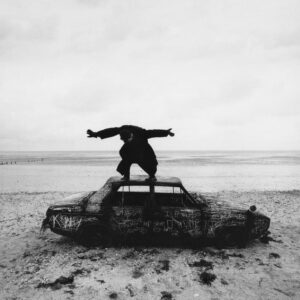Time and time again, we’ve seen the culture-defining bands of yesteryear fall so easily into the inescapable pit of mediocrity. A band releases a few hits, gets too confident, and proceeds to produce large quantities of the most subpar music imaginable for the rest of time. Fueled by their initial commercial success, they have an insatiable hunger for excess; they just don’t stop, even when it seems like everyone is begging them to. It’s incredibly rare for a band to drop a carefully crafted and beautifully imagined album after a hiatus of over a decade.
The Cure defies these expectations.
After 16 years of a music drought, the paradigmatic gothic rock band released a new album entitled Songs of a Lost World (2024) on Nov. 1. At 65-years-old, frontman Robert Smith remains the only original member of the band, but he carries the gloomy yet glorious spirit of the band from 1978 to 2024 astonishingly well.
From the first notes of the album opener “Alone,” it’s clear that this isn’t just any comeback album—it’s a work of art. The sparkly keys, the moody percussion, the reluctant interjections from a guitar, and Smith’s tortured vocals all feel like brushstrokes from an expressionist work by Kandinsky, bold and contradictory yet perfectly harmonious. As Smith lends his brokenhearted voice to the ethereal gloom of the instrumentation, the lyrics lament the inevitable end. “And here is to love, to all the love / Falling out of our lives / Hopes and dreams are gone / The end of every song,” Smith cries, drawing the listener into the dark chasm of hopelessness that is the genesis of the album.
But soon after this violently dark opening, a glimmer of hope flashes. The tender piano and delicate strings intro of “And Nothing Is Forever” soothes with a coolness that counteracts the burning agony of “Alone.”
Although no song by the Cure is free of their characteristic tinge of gloom, the second track on the album taps into a sense of enchanting optimism seen on previous hits of theirs, such as “Lovesong” (1989) and “Friday I’m In Love” (1992). Serving almost as a response to the utter nihilism of the first track, Smith expresses that although everything must end, what really matters is the endurance of love: “I know, I know / That my world has grown old / But it really doesn’t matter / If you say we’ll be together / If you promise you’ll be with me in the end.” Songs like these save the Cure from homogeneity—when contrasted with their usual doom and gloom, it becomes apparent that they hold a quiet power in their talent for musical variety.
The variety doesn’t stop with hopeful love songs. The Cure has perfected their portrayal of anguished intensity while exploring the realm of gritty, electric chaos. “Warsong” is industrial, oppressive, and intense. The pure emotion exhibited by Smith’s vocals feeds the song’s core messaging, one akin The Cure’s usual somber themes: love is war. The catchiest song on the album, yet possibly the largest detraction from The Cure’s typical oeuvre, “Drone:Nodrone” has electric, wailing guitar riffs shooting out like bolts of lightning among the chaos of the heavy song about uncertainty and inner turmoil. There’s something so captivating about the vitality and energy of “Drone:Nodrone” in contrast with the deathly feel of the rest of the album.
If “Warsong” and “Drone:Nodrone” are rough blocks of concrete, “All I Ever Am” and “I Can Never Say Goodbye” are flawless slabs of polished marble. The existential dread of the lyrics in “All I Ever Am” are refined by the smooth, methodical music they’re set to. Atop the vessel of the lustrous instrumentation, the lyrics sail through murky waters of despair without fully sinking into their depths. Likewise,“I Can Never Say Goodbye” is a beautiful, sorrowful tribute to Smith’s late brother. The grief-filled sixth track gingerly delves into the pain of bereavement with a depth and honesty unparalleled by the rest of the album.
The second single from the album, “A Fragile Thing,” offers a change of pace with lighter lyrics (still despondent, of course, because this is still the Cure) that analyze the anatomy of a relationship. When talking about the album, Smith categorized this one as “the love song on the album,” commenting that “love is the most enduring of emotions, it’s the most powerful emotion, it’s incredibly resilient. And yet at the same time incredibly fragile.” This tension between power and fragility is perfectly conveyed throughout the album in the Cure’s juxtaposition of forceful instrumentals and emotional, tender lyrics.
The winding, 10-minute “Endsong” closes the album right where it started, with an unrelenting nihilism and a dramatic guitar that match the first track, providing Songs Of a Lost World with a fittingly cohesive conclusion. Smith somberly reflects on the concept of endings: “It’s all gone, it’s all gone, it’s all gone / Left alone with nothing at the end of every song.”
Songs Of a Lost World is a bitterly achy yet cathartic journey into a world of shadows and deep emotional turmoil, reviving the goth rock movement of the ‘80s and ‘90s in a timeless way. With artfully arranged instrumentation and Smith’s unparalleled brilliance, Songs Of a Lost World is a pinnacle in modern music, soaring above uninspired radio hits to provide the listener with a deeply transformational, immersive experience—it’s what music should be.
Voice’s Choices: “Alone,” “Drone:Nodrone,” “All I Ever Am”





